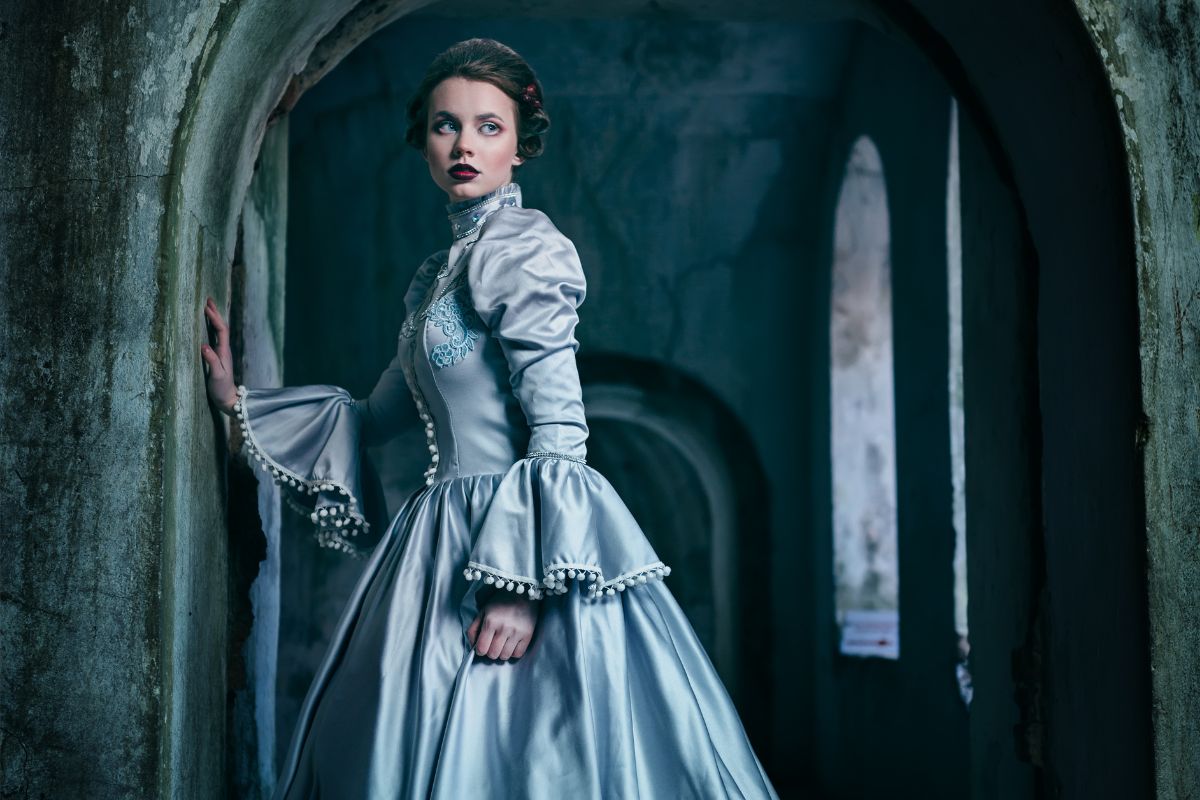Philippa Gregory is one of the most famous historical writers in the world.
Her books focus on a range of different eras, from the English Civil War to Tudor England.

From tragic romance and fierce revenge to political secrecy, you want to make sure that you read Philippa Gregory’s historical Tudor novels in reading order to see how Tudor times develop.
As an author who prides herself on historical accuracy, she portrays the power struggles that particularly women across society have to deal with in their time.
While Gregory’s novels are historic fiction, her work is so well-researched and written that readers can get a fantastic understanding of the time period.
She has written 15 Tudor books that cover the beginnings of the Tudor era from The War of the Roses all the way to Elizabeth I’s death.
With so much choice of incredible reading material, it can be tricky to find a good starting point.
That’s why we put together a list of all of Philippa Gregory’s historical Tudor books in reading order.
About Philippa Gregory’s Historical Tudor Novels
English historical novelist Philippa Gregory published her first book in 1987 and she has written over 30 books about various historical eras so far.
However, some of her most famous books are about royal women of the Tudor period, especially the wives of King Henry VIII.
Gregory’s most popular novel The Other Boleyn Girl was published in 2001 and it won the ‘Romantic Novelists’ Association’ Romantic Novel of the Year Award just a year later.
In 2008, The Other Boleyn Girl was turned into a movie that earned Philippa Gregory the title of “the queen of British historical fiction” by AudioFile Magazine.
While Gregory has written novels set in other historical periods as well, her books about the 16th-century Tudor period gained the most traction with readers.
Two years after its publication, The Other Boleyn Girl was also turned into a British television drama, starring Jared Harris, Jodhi May, and Natascha McElhone.
After the success of The Other Boleyn Girl, Philippa Gregory followed her most popular Tudor novel with a number of sequences, including The Virgin’s Lover, The Other Queen, The Queen’s Fool, and The Boleyn Inheritance.
Philippa Gregory doesn’t just write historic novels but she also contributes to newspapers and magazines with reviews, features, and short stories.
She is regularly seen as a Tudor expert on different TV programs.
Her specialist subject is Elizabeth Woodville who has inspired many of her Tudor novels.
Philippa Gregory’s Historical Tudor Novels In Reading Order
With 15 historical novels about the Tudor era, Philippa Gregory has written more about this time than many other novelists.
In order for readers to understand the events and historical figures of the time, Philippa Gregory has recommended a specific reading order for her entire Tudor series.
So, here is the best reading order for Philippa Gregory’s historical Tudor novels.
The Lady Of The Rivers
The Lady of the Rivers may not have been Philippa Gregory’s first published book but the story is set earliest in the Tudor period.
This book follows the life of Jacquetta who helps her family through power struggles during one of the most bloody conflicts in England’s history, the War of the Roses.
She navigates not just the treacherous path of power up the social ladder but the threat of war is also coming ever closer to Jacquetta’s door.
Suddenly, Jacquetta is caught between her own visions for the future and the power struggles at the English court.
A secret marriage doesn’t turn out to be as good as expected, so she puts all her efforts into creating a future for her beloved children.
And this is not just any future but ruling the country with a firm hand.
But fortunes change from one day to the next, and Jacquetta learns this sooner than she had expected.
The Lady of the Rivers is based on true historical events surrounding Jaquetta of Luxembourg.
Pros
- This fantastic work of historical fiction focuses on a woman who has had little attention in books so far, Jacquetta of Luxembourg.
Cons
- Some readers found that the use of the present tense in the book was confusing.
The White Queen
The White Queen is undoubtedly Gregory’s most famous Tudor novel.
Made into a miniseries and a film, the story of Elizabeth Woodville captured thousands of readers and viewers.
Jacquetta’s daughter, Elizabeth Woodville, has grown into a beautiful woman with great ambitions.
Just as fate willed, the young lady meets the newly crowned King Edward IV on a ride out one day.
While the two had a very different upbringings and social standing, Edward and Elizabeth can’t ignore their love and they quickly get married in secret.
From one day to the next, Elizabeth finds herself to be queen.
Despite the outrage at the English court, Elizabeth quickly rises to the demands that her new role requires.
But this is not just a story about Elizabeth Woodville’s life. Also, her two sons find themselves pawns in a struggle for the throne until they mysteriously disappear.
The White Queen is based on real historical events and characters, including the main character Elizabeth Woodland and her rise to the English throne.
Pros
- Elizabeth Woodville is Philippa Gregory’s favorite subject and this shows in her great writing style.
Cons
- Some readers were disappointed that the book isn’t the same as the television series.
The Red Queen
The third book in Gregory’s Plantagenet and Tudor books series is The Red Queen.
This book follows the life of the heiress to the red rose of Lancaster, Margaret Beaufort.
It was a time when women had to fight for their rights, especially their right to be heirs to the throne of England.
Margaret Beaufort still believes in her right to rule and her great destiny as ruler of England.
Margaret was married off early to a man who was twice her age. He died quickly after the wedding, leaving his teenage wife alone with a young child.
But Margaret doesn’t surrender to her lonely fate.
She sets plans into motion to get her son on the English throne, no matter what price she or her little boy have to pay for it.
After she sends her son Henry into exile in France where she knows he is safe, Margaret starts one of the greatest rebellions in English history.
But plans don’t always work out the way you want them to.
Margaret learns quickly that she has to move with the shifts and changes of her time.
Pros
- The character of Margaret Beaufort is beautifully varied and a lot more realistic than in the Starz miniseries The White Queen.
Cons
- Some book reviews of the Red Queen found that Margaret Beaufort is portrayed as an extremely religious woman although there is no historical proof for that.
The Kingmaker’s Daughter
In the fourth book of Philippa Gregory’s Tudor novels, the reader jumps back to the same time as The White Queen.
The story follows a beautiful young woman called Anne Neville.
Despite her great knowledge of the rules and ways of the English court, Anne doesn’t see how her father uses her and her sister for his own political gains.
As the Kingmaker, Richard Neville is one of the most influential men in fifteenth-century England.
As he doesn’t have a son as an heir, he uses his two daughters to grow his influence around the king.
Although Anne grew up around the court of Elizabeth Woodville, she can only helplessly watch how her father makes more and more enemies.
This dangerous game of Richard Neville will not just bring danger into his life but also collide with the fate of the royal family.
The Kingmaker’s Daughter features historic events and real characters that lived during the Tudor period, including Anne Neville and her sister Isabel.
Pros
- The Kingmaker’s Daughter is Philippa Gregory’s first story about sisters after The Boleyn Girl.
Cons
- Some readers interested in Richard III doubted the historical accuracy of his character in the book.
The White Princess
Elizabeth of York is the daughter of the White Queen and she is the main character in Philippa Gregory’s book The White Princess.
In Gregory’s typical writing style, this book follows the life story of one of the strongest women in English history.
As the War of the Roses comes to an end and Henry Tudor claims the English throne, he must marry the daughter of his enemy, Elizabeth of York.
In order to unify the country and end the war, his bride is a pawn in a political game.
But the heart of strong-headed Elizabeth is still with another.
Henry and Elizabeth quickly get caught up in a plot to overthrow the new monarchy and reinstate the House of York.
And soon, Henry’s greatest fears of losing his throne seem to become reality.
The White Queen is another Philippa Gregory book that features real events and characters from the 15th and 16th Centuries.
Pros
- This story about Elizabeth of York’s life and the beginning of a united England is compelling and well-written.
Cons
- Philippa Gregory’s The White Princess talks about actual historical events but the book also contains a lot of narrative license.
The Constant Princess
The sixth book in Philippa Gregory’s recommended reading order of her Tudor novels is The Constant Princess.
This is the first book that features the well-known Tudor court, beginning with the fate of Katherine of Aragon who later married King Henry VIII.
As the Princess of Spain, she was betrothed to Prince Arthur of England from an early age.
But fate strikes a tragic blow when Arthur dies unexpectedly shortly after their marriage.
On his deathbed, Katherine promises her still-husband that she will marry Henry and create a thriving England together.
Dreams aren’t as easy a promise, however.
Widowed Katherine struggles with life at a Tudor court and she has to fight hard to convince her father-in-law that the marriage with Arthur wasn’t ever legal.
It takes a long seven years for her pleas to be finally heard, and she can step into her long-promised role of Queen of England.
But before she can enjoy married life, there is one last battle she has to fight.
Katherine of Aragon is one of the most famous historical figures in English history. The Constant Princess shows the strength of this powerful woman and her life story.
Pros
- The Constant Princess is stunningly written and it portrays Katherine of Aragon in a historically accurate light.
Cons
- Some readers and reviews found The Constant Princess too repetitive.
The King’s Curse
After The Constant Queen followed the story of the Tudor court of Henry VIII, The King’s Curse steps a little back in time, showing the life of Margaret Pole.
Margaret is the cousin of Elizabeth of York. As part of the nobility, she is married off to the placid and calm Sir Richard Pole.
Pole supports the house of Lancaster and, as thanks for his loyalty, he is entrusted by the king with the administration of Wales.
Margaret and Richard live a contented life until young Prince Arthur and his new bride Katherine of Aragon arrive.
In a short time, Margaret becomes a trusted advisor to the couple but her world is turned upside down again with Arthur’s sudden death.
As a new lady-in-waiting to the new Queen Katherine, Margaret finds her place at the English court and she soon discovers that she has to find her own way amongst the fighting Tudors.
The King’s Curse features historically accurate events and characters, including the little-known Margaret Pole.
Pros
- Many readers loved The King’s Curse because it followed a noble woman who gave a behind-the-scenes look at royal life at the Tudor court.
Cons
- The King’s Curse is very similar to Gregory’s other books in writing style and plot.
Three Sisters, Three Queens
Katherine of Aragon, Mary Tudor, and Margaret Tudor, have a special bond that cannot be so easily broken.
But their fate entwines in so many different ways.
All of them are queens in different countries across Europe. Their children and husbands die and they struggle to hold power in their courts.
Three Sisters, Three Queens is the story of three women who live separate lives but still experience the same fate of loss, betrayal, and passion.
Pros
- This story gives the reader a more complete picture of Tudor times in England and across Europe.
Cons
- Some readers were disappointed by the character of Margaret Tudor.
The Other Boleyn Girl
There is no doubt that The Other Boleyn Girl is Philippa Gregory’s most famous Tudor book.
Following the story of the two Boleyn sisters, Mary and Anne, the plot takes place in one of the most turbulent times in England’s history.
While Mary holds King Henry’s affections for just a while, Anne has greater plans for her own rise to the throne.
Even when Henry VIII finally discovers his love for Anne, she doesn’t give in so easily. But courtship comes at a price as Anne soon finds out.
Pros
- The Other Boleyn Girl is a classic story about two sisters who are different in the way they love and live.
Cons
- Some readers noticed that Philippa Gregory deviated a lot from historical facts in this book.
The Boleyn Inheritance
After the tragic end of Anne Boleyn, Henry VIII’s England descends into chaos but he is already looking for a new queen.
Drawn between a political alliance and the desire for a younger woman, Henry doesn’t realize that behind his back three women aim to be his new bride.
Passion, lust, and intrigue are just a few ingredients of The Boleyn Inheritance.
Pros
- The Boleyn Inheritance is a worthy sequence to Gregory’s famous story of the Boleyn sisters.
Cons
- Some readers found that this book repeats a lot of information, similar to The Constant Queen.
The Taming Of The Queen
Katherine Parr may have known how to deal with the many ailments of King Henry but even his sixth wife wasn’t safe from accusations of heresy.
When Henry VIII ordered Katherine to marry him, she already knew that these are dangerous times to be the wife of a king.
But Katherine is an independent woman who knows how to find her own way at the aging king’s court.
Pros
- This historical work of fiction features the many sides of King Henry VIII’s sixth wife, Katherine Parr.
Cons
- Some reviewers found The Taming of the Queen not as exciting as The Other Boleyn Girl.
The Queen’s Fool
With the death of King Henry VIII, a long era of religious persecution and terror came to an end in England.
Unlike many other historical fiction books from Philippa Gregory, The Queen’s Fool tells the story of a young girl who is a servant to Queen Mary.
Hannah quickly discovers the power struggles and dangers that lurk throughout the court.
Pros
- This book is well written and the exciting story wants you to read more from Philippa Gregory.
Cons
- Some reviews find that the main character, Hannah, isn’t well-developed.
The Virgin’s Lover
After Elizabeth I descends on the English throne, she finds the country almost bankrupt and war with Spain is imminent.
While many of her advisors push the new queen towards marriage, Elizabeth is certain that she can give England a bright future without a husband.
But there are many fires that burn within this young queen that she longs to follow.
Pros
- In this fantastic book of Gregory’s Tudor saga, the virgin Queen Elizabeth I is shown as a woman with heart, passion, and lust.
Cons
- Some readers of The Virgin’s Lover found that Elizabeth didn’t show the same strength as many others of Gregory’s characters.
The Last Tudor
The Last Tudor follows the aftermath of Henry VIII’s death and all the women and children he left behind.
Jane, Katherine, and Mary Grey are the key protagonists of this exciting historical fiction.
Pros
- This is a suspenseful story with many twists and turns.
Cons
- Some readers were disappointed that the story ended before some key events.
The Other Queen
The final book in Philippa Gregory’s Tudor series follows the story of Mary Queen of Scots.
The cousin of Queen Elizabeth I is imprisoned because of the part she played during the rebellions in England.
But Mary isn’t content with her fate, so she starts to plot both her escape and her ascend to the throne.
Pros
- The Other Queen gives an insight into the world of spies and secrecy in Tudor England.
Cons
- Some readers found the repetitions in The Other Queen too distracting from the story.
Final Thoughts
Philippa Gregory’s Plantagenet and Tudor novels series is undoubtedly the most popular collection of Tudor literature.
Gregory strives for historical accuracy in all her books but it’s important for readers to remember that she seamlessly blends historic figures and events with fictional elements.
Some of Philippa Gregory’s novels also made it into famous television series and films.
The Other Boleyn Girl and The White Queen are two of the most famous television adaptations of various Tudor novels by Philippa Gregory.
The series and film are condensed versions of the books, so if you want to discover the entire story of Philippa Gregory’s Tudor England, then it’s a good idea to read her books in the recommended reading order.
Frequently Asked Questions
What Genre Does Philippa Gregory Write?
Philippa Gregory is a well-known author of historical fiction novels. She writes about a wide range of different time periods, including the English Civil War and the Tudors.
What Books Is The White Queen Based On?
The British historical television drama The White Queen is based on Philippa Gregory’s novel series The Cousin’s War.
The series consists of three books, including The Red Queen, The Kingmaker’s Daughter, and The White Queen.
Is The White Queen Historically Correct?
Yes, Philippa Gregory’s book The White Queen is based on historical events that truly happened.
While the private character interactions and emotions are fictional, the characters themselves, including Elizabeth Woodville, and the plot is based on real events.
- Peter James’s Bestselling 19 Roy Grace Books In Order - June 2, 2023
- The 5 Best Novels About Alexander The Great - May 26, 2023
- 38 Amazing Literary Books To Get Lost In - May 26, 2023


